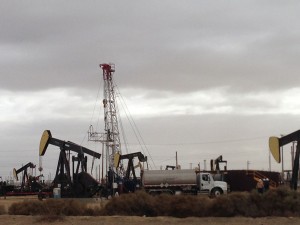
Rosanna Esparza, Kern County Oil and Gas Program Organizer
The majority of Californians live in counties with unhealthy air. But nowhere is the air unhealthier than in the San Joaquin Valley.
The San Joaquin Valley has never met the federal health standards for smog. Never. In fact, Valley residents face some of the worst smog pollution in the country. If you live in Kern County, home of the largest oil fields in California, the air you breathe may put your health at risk. Residents face a host of pollutants and toxic chemicals from the oil & gas industry, smog-forming emissions from fuels, vehicles, machinery and engines.
How bad is it?
The 2014 Kern County State of the Air Report from the American Lung Association gave Kern failing grades for Ozone, Particle Pollution in 24-hours and Annual Particle Pollution.
The referenced media source is missing and needs to be re-embedded.
Oil and Gas Operations- Ozone air quality is considered unhealthy or worse for nearly two-thirds of the year.
- The San Joaquin Valley has some of the nation’s worst air quality, failing to meet federal health standards for both ozone (smog) and particulate pollution. Theses challenges are unparalleled in the United States.
- The CA EPA and San Joaquin Valley Air Pollution Control District must install air monitoring stations in areas of high risk (Elk Hills, Lost Hills, Buttonwillow, Shafter, Wasco) to capture accurate, real-time data
- Banning open pits. Off gassing wastewater needs to be stored in closed loop systems so volatile organic compounds are contained. Local and state regulators have the power to make this happen.
- Stronger air pollution controls and oversight on all oil production facilities. The Air Resources Board is moving towards regulating methane
- Today there are nearly 2,000 solar companies at work in CA, employing over 47,000 people. Thousands more jobs and millions of dollars in economic activity could be created if we tap into the full potential of this technology. (Pollution free solar energy)
- In the last four years California’s clean energy generation has more than doubled. The price of wind and solar energy is becoming more affordable and reliable opening the door to powering our homes and cars with 100 percent clean resources.
- Polluters need to hold up their end of the bargain to reduce health impacts from air pollution.
- We can’t ignore transportation’s impact on our air. Building an affordable electric vehicle infrastructure will create jobs; reduce pollution, and significantly cleaner air.
Related Posts
Stay Informed
Get the latest updates and actions:
Thanks for signing up!
There was a problem processing your signup. Please try again.


